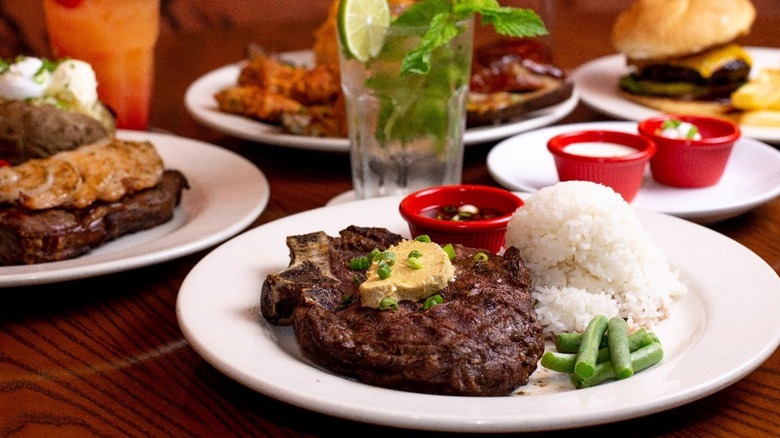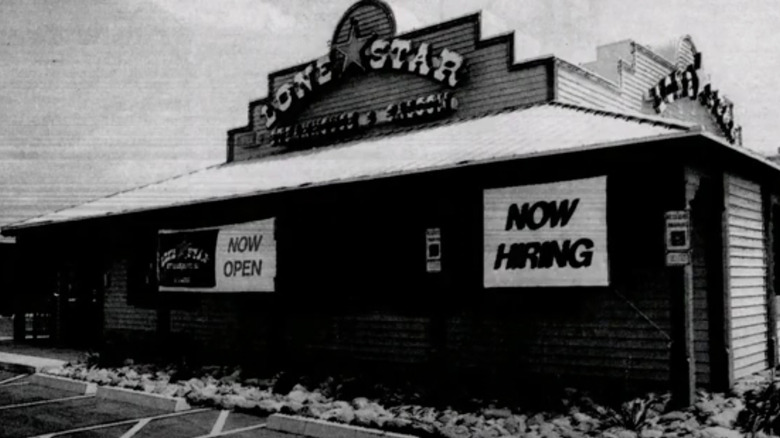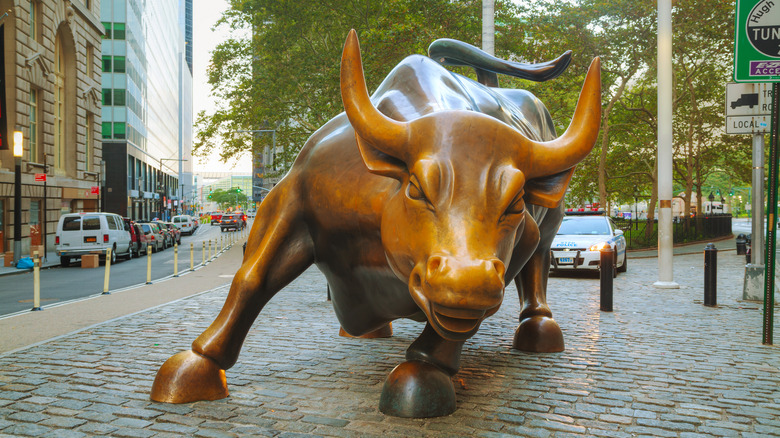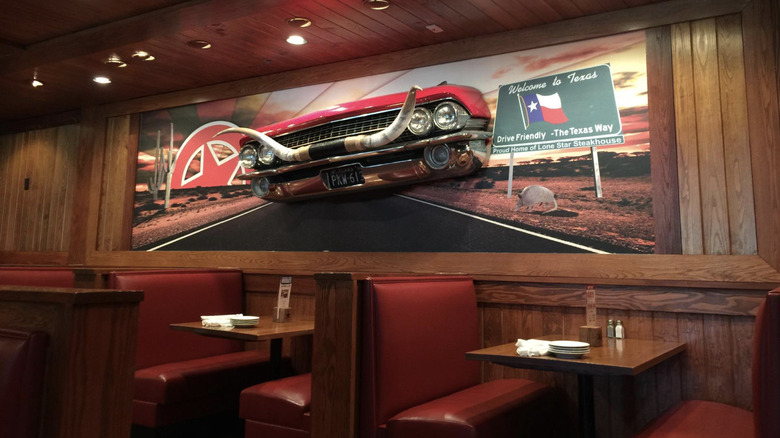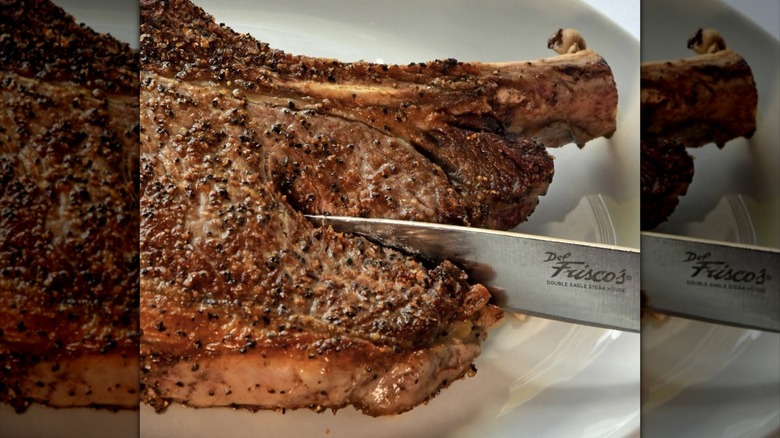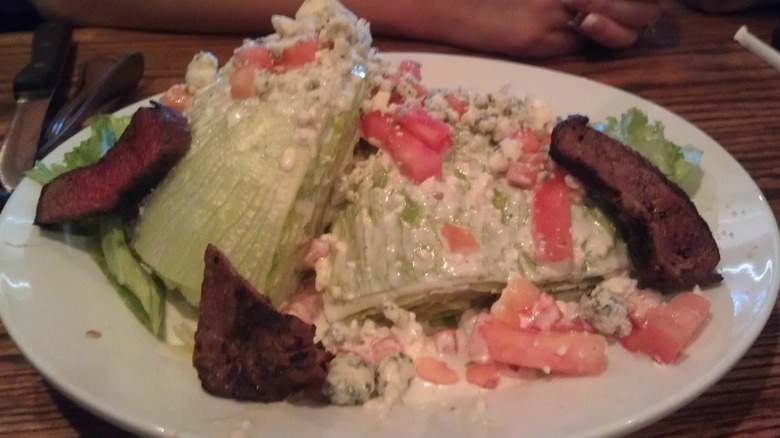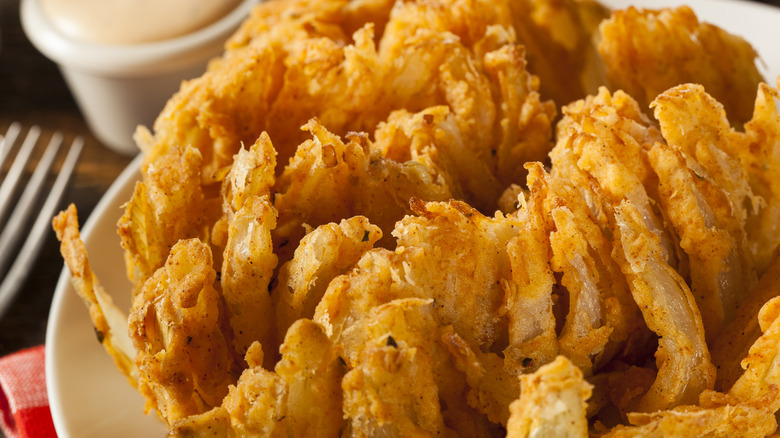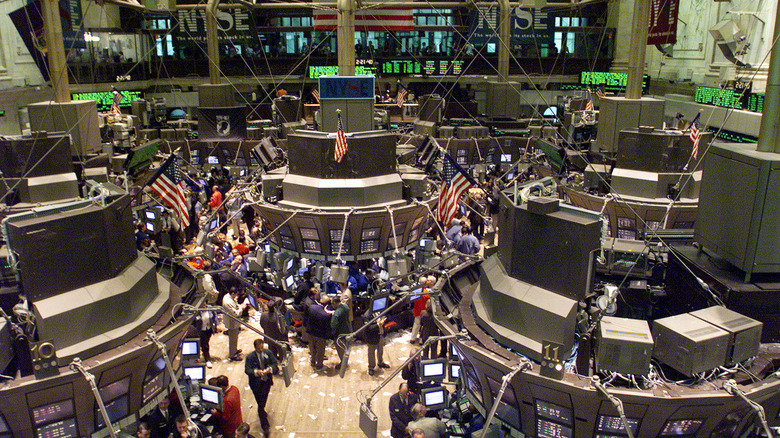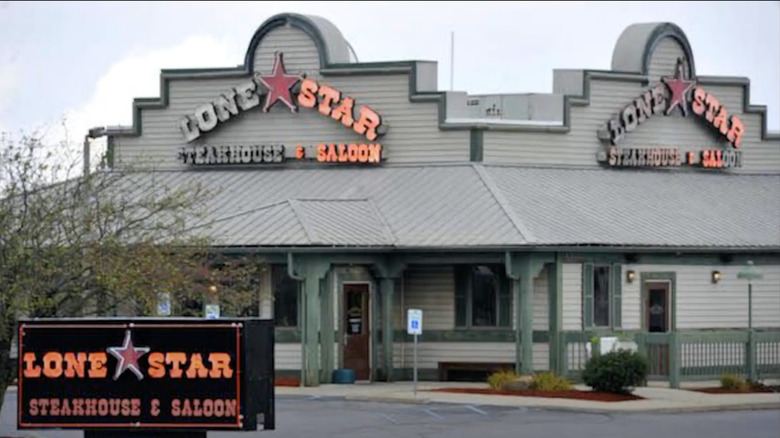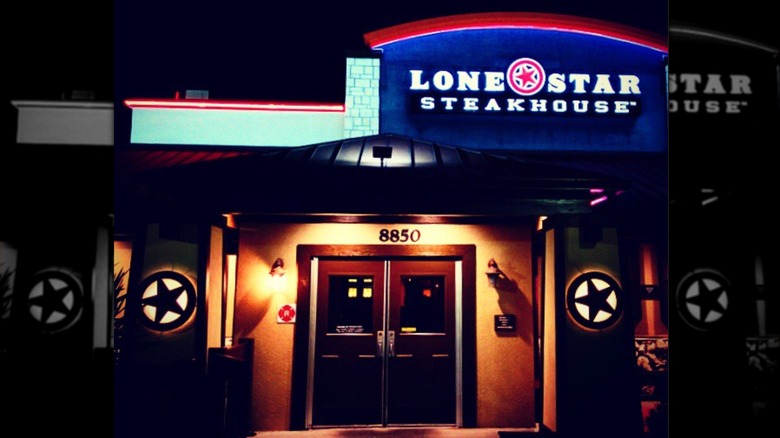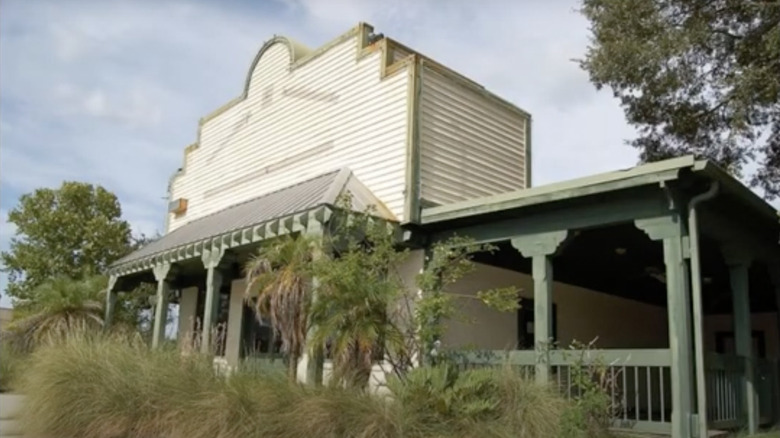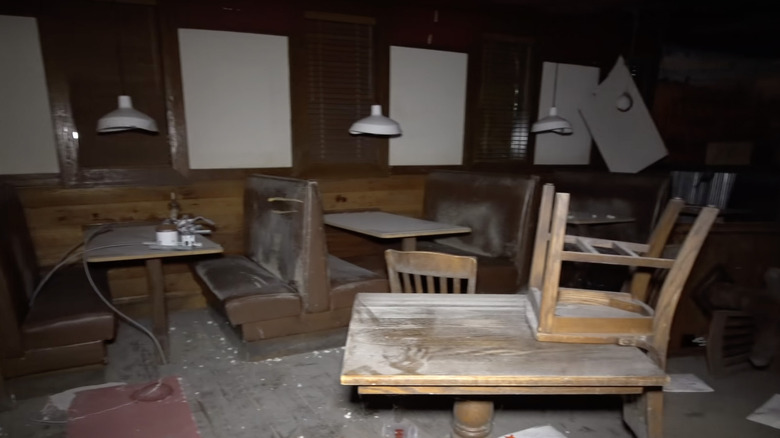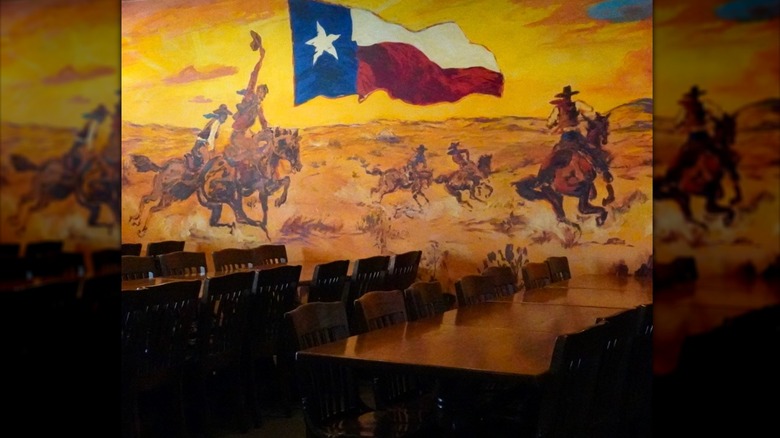The Rise And Fall Of Lone Star Steakhouse
For the better part of the '90s, you could throw a rock in the suburbs and hit a casual steakhouse restaurant. One such place was Lone Star Steakhouse, a former prototype that multiplied into a successful chain with over 200 restaurants by the early 2000s. For three decades, Lone Star Steakhouse was a viable part of middle American dining culture until its presence in the continental U.S. completely vanished.
Lone Star Steakhouse was not the first of its kind but it was an early adopter of the food and decor trends that can still be seen at steakhouses today. What's more, its affordable prices, lively atmosphere, and widespread accessibility helped the Texan-themed steakhouse rise to the ranks of greatness. Yet things have since gone so wrong for Lone Star that it only has a single location left.
To many, this is a tale about a company that, like so many other struggling steakhouse chains, floundered in an over-saturated market. With nothing able to set Lone Star apart from its many competitors, much of its downfall had to do with its see-sawing presence on the stock market, executive errors, and destabilizing mistrust amongst the company's shareholders. For Lone Star, it became less about the food and more about trying to rescue a once-promising chain that never forged a genuine brand identity. To find out what happened, we'll need to start at the beginning. Here, we'll revisit Lone Star Steakhouse's early days and chronicle its troubled trek into restaurant ruin.
Lone Star Steakhouse & Saloon was developed by a franchise expert
Jamie Coulter didn't invent the concept for Lone Star Steakhouse, but he certainly ran with it. As a young entrepreneur based in Wichita, Kansas Coulter and two friends began franchising Pizza Hut restaurants in the 1960s under CWG Enterprises. After opening over 170 Pizza Hut locations and expanding its scope to the KFC franchise, CWG and Coulter parted ways. Coulter established Coulter Enterprises and continued franchising with Pizza Hut. In late 1989, Coulter was invited to take a look at a new prototype restaurant that was being developed in Winston-Salem, North Carolina. That restaurant was the Lone Star Steakhouse & Saloon.
The prototype for Lone Star was developed by the company Creative Culinary Concepts. The food was meant to emulate the mesquite grill pits that became popular in Texas in the late 19th century. The decor and ambiance drew inspiration from the boisterous Western-style roadhouses of yore. Coulter saw potential and went into business with Creative Culinary Concepts in 1991. Within seven months, Coulter opened four additional Lone Star units.
The early Lone Star Steakhouses specialized in mesquite grilling, with a menu that featured a variety of steaks, barbeque ribs, chicken, and a seafood option. Each location measured 6,000 square feet and could seat up to 200 customers at a time. But Coulter, a man who by then was used to overseeing a small army of Pizza Hut locations, wasn't satisfied with just a few Lone Star units.
To expand, Lone Star needed help from Wall Street
Coulter incorporated Lone Star Steakhouse in 1992, but to take his young steakhouse to the next level, he would need some backing from Wall Street. That year, Lone Star became a publicly traded company in the stock market. At the time it went public, there were eight locations, with each unit generating roughly $2.5 million in annual sales.
The decision to enter the stock market was a quick success. The early '90s were a great time for restaurant stock, with many chains performing spectacularly and steakhouses, in particular, riding the wave. A Los Angeles Times article from December 1992 noted that Lone Star's stock price had risen a staggering 433% since its initial public offering (IPO), selling for $36 per share.
By 1996, the total number of Lone Star Steakhouse locations had grown to 175 units and showed no signs of slowing. Smaller, struggling chains became prime targets of Lone Star's rapid expansion. In April 1994, Bill Knapp's, a family restaurant chain dating back to 1948, sold all nine of its Florida locations to Lone Star Steakhouse. At the time, Lone Star's future looked promising, but as casual steakhouses began popping up everywhere, the market was becoming oversaturated.
Lone Star helped create the modern casual steakhouse scene
A restaurant floor caked in peanut shells and impromptu line dances courtesy of waitstaff were surefire signs you were in a cowboy-themed steakhouse. They were curious style choices to the outsiders, but we grew to expect them at places like Lone Star, Texas Roadhouse, and others. These days, steakhouse chains referencing the Old West are everywhere — the litter of peanut shells, luckily, is not. It can be said that Texas Roadhouse mimicked a lot of what Lone Star Steakhouse helped make mainstream. Texas Roadhouse opened in Clarksville, Indiana in 1993, right on the heels of Lone Star's inception. Over the years, it became hard to distinguish what set them apart. Now, the main difference between the two is that Texas Roadhouse is thriving
That's in large part because Lone Star Steakhouse's brand identity wasn't exactly original. The once-popular (and now nearly extinct) Ponderosa and Bonanza Steakhouses came about decades earlier in the '60s and sported a heavy-handed country-western vibe. Likewise, LongHorn Steakhouse has been around since 1981, and although it doesn't sally forth with gimmicks like line dancing on a peanut shell-covered floor, it too celebrates old-school Texas grill culture.
Yet, at least back in the late 1980s, the Wild West schtick didn't feel redundant and many of these eateries, like Steak & Ale (poised for a 2024 return) and the now-defunct Mr. Steak, were cashing in on other themes — or in some cases, no theme at all.
For years, the accolades (and money) rolled in
The early years of Lone Star were truly the halcyon days of the steakhouse. President, C.E.O., and Chairman of the Board Jamie Coulter led the chain into widespread profitability by making it a publicly traded company. Lone Star's success was acknowledged with some impressive accolades. In 1993, 19994, and 1995 Forbes magazine named Lone Star Steakhouse the best small company in America. Fortune Magazine's 1994 list of the 100 fasted-growing companies in the country ranked Lone Star sixth — the highest placement earned by a restaurant that year. By 1995, Lone Star's total restaurant count had reached 182 units.
Ever the shrewd businessman, Coulter decided to begin exploring expansion options beyond the Lone Star name. He aimed to break his way into a very specific market: the lower margins of the upscale steakhouse industry. Coulter's goal materialized in the form of Sullivan's Steakhouse, which opened for business in 1996. Sullivan's touted an Art Deco aesthetic and specialized in dry-aged steaks, seafood, and cocktails.
Just as Sullivan's was underway, Coulter and his business partners made a power move, purchasing Del Frisco's Double Eagle Steakhouse for $23 million in cash and stock. Del Frisco's Double Eagle represented the upscale tier of steakhouses — it was the top-earning restaurant in all of Texas in 1995, with $12 million in sales. With two new ventures in a higher-end of the steakhouse market, Coulter had his hands full, and Lone Star wasn't the center of attention anymore.
Despite the success, Lone Star cut corners early on
Lone Star Steakhouse opened more and more restaurants into the mid-1990s, but this staggering growth rate didn't exactly mean it was serving high-quality food. A 1995 restaurant review from Deseret News is a case in point, with a review that first warned: "Always beware the restaurant with a major gimmick." It got worse.
The dining experience told of chinks in the hospitality efforts, as the server oddly went by different names through the meal, while an unpleasantly aged bit of salmon was swapped for a fresher cut. Arguably the most troubling issue the critic found concerned a filet mignon of sorts that the restaurant manager removed from the tab. "[We] discovered it consisted of three grainy, inferior cuts of sirloin held together with a wooden pick, then wrapped with charred bacon." The manager explained that it was a thing kitchen staff did when the filets ran out, apparently without managerial oversight.
We can't imagine encountering this in a major chain steakhouse in the 2020s, but it's not as if 1995 was the Stone Age. Coulter once credited Lone Star's expansion power to the strong relationship between the restaurant's general managers and its corporate headquarters. He maintained that this hierarchical structure was the reason why Lone Star didn't employ district or regional managers as go-betweens. If this were truly the case, however, we suspect Coulter would have known that certain locations that were operating at a subpar standard.
Outback Steakhouse always seemed one step ahead
Lone Star was at the helm of a booming era for casual steakhouses, but it also ushered in stiff competition. One of its biggest competitors: Outback Steakhouse. The Australian-themed eatery got its start in Tampa, Florida in 1988. Lone Star and Outback rose to prominence at almost the same time and offered near-identical items on their respective menus.
One area where Outback outshone Lone Star was marketing. From the beginning, both chains sold a breaded and deep-fried onion appetizer with a creamy dipping sauce. Lone Star failed to nail down an exact name for its savory starter — it was originally called the Texas Tumbleweed and at some point was known as the Texas Rose. Outback called its version the Bloomin' Onion and ran a series of advertisements so successful that the dish is today a singular must-try item on the Outback Steakhouse menu.
By the early 2000s, the budget steakhouse arena was utterly oversaturated and the sales of former top-performing chains began to decline. Outback pivoted with ease, having diversified through sister brands like Carraba's Italian Grill and Bonefish Grill. Since these restaurants were far enough removed from the steakhouse space, they performed well and helped Outback weather the storm. Lone Star had a couple of sister restaurants too, but they were both also steakhouses. The lack of variety failed to provide a safety net, something Lone Star would end up needing soon.
By the late '90s, Lone Star showed signs of tarnish
Restaurant sales were steady into the late '90s, but Lone Star's stock market performance was abysmal. For a company that relied on shareholder loyalty, this was all the more worrisome. It also didn't make a whole lot of sense. In the late '90s and early 2000s, the stock market was enjoying the lengthiest bullish era it had ever seen up to that point. A bull market, as opposed to a bear market, is when the broad market index of stock prices rises 20% or more for at least two months. Bull markets are usually a hopeful time on Wall Street, and yet Lone Star's stocks were sinking.
There are a couple of reasons why this happened. In an attempt to maintain its existing profit margins, Lone Star scaled back on advertising and raised its menu prices — not exactly the best move to get more people through the door. There were 205 Lone Star Steakhouses in 1997, so did the company confuse its sheer number of locations for customer loyalty?
Lone Star's problems in the stock market were made worse by the fact that Coulter had sold off 1.2 million of his Lone Star shares in the spring of 1996 when the stock price was $44 a share — a company high. Four years later, that price would plummet a shocking 85%, making it all worth less than $7 a share at the start of the millennium.
An executive shakeup brought some hope, but it didn't last
Coulter's entrepreneurial savvy was undeniable, but as time went on, his management of Lone Star Steakhouse funds became the subject of scrutiny. Lone Star's shareholders had a right to be angry. as those who had invested $100 in Lone Star Steakhouse stock in 1995 were left with $22.08 by the end of 2000. The California Public Employees Retirement System (Calpers), a company then with over 372,000 shares of Lone Star stock, sued Coulter in 2001. The lawsuit indicated that while stock prices nosedived, Coulter and another board member had quadrupled their earnings and padded their future severance agreements.
In 2000, a small-time shareholder named Guy Adams sought to replace Coulter as Lone Star's Chairman of the Board. Lone Star reacted by suing Adams, but Adams ended up winning Coulter's board seat in a landslide vote. Although he was deposed from the board, Coulter remained C.E.O. After Adams replaced Coulter, Lone Star's stock price more than doubled.
Changes at the executive level were dramatic and yet business goals and outcomes were shaky. The ailing steakhouse aimed to go private and attempted a merger with investment firm Bruckmann, Rosser, Sherill & Co. LLC, but the deal didn't come to fruition. Lone Star felt the sting and then some: its sales dropped by $1.14 million in 2002.
A 2006 buyout took Lone Star private
Years of stock market instability and fluctuating sales motivated Lone Star's desire to return to the private sector. Four years after a failed merger with private equity firm Bruckmann, Rosser, Sherill & Co. LLC, Lone Star Steakhouse was bought out in 2006 by Lone Star Funds (LSF), a Dallas-based firm related to Lone Star Steakhouse in name only. LSF specialized in buying hurting businesses and acquired Lone Star for roughly $600 million.
By retreating into the private sector, Lone Star could address its issues away from the ever-scrutinizing eye of Wall Street. True to form, Lone Star's former shareholders weren't happy with the LSF deal, citing that the restaurant's real estate should have been reappraised before the companies had drawn up the contract. At the time of acquisition, Lone Star had 222 locations. Its sister companies Sullivan's Steakhouse, Del Frisco's Double Eagle, and Texas Land & Cattle, the last of which was purchased for around $20 million in 2004, accounted for another 40 units. LSF acquired everything.
Lone Star's shareholders received $27.10 cash per share, but skeptics maintained the steakhouse was worth more than what it sold for. After the buyout, LSF attempted to modernize Lone Star's dated rodeo look. It also rolled out plans to take Sullivan's and Del Frisco's public in hopes of geographic expansion. A $100 million IPO was filed in October 2007, leaving Lone Star in the dust.
The recession only made things harder
The Great Recession hit hard in December 2007, putting businesses of all kinds under serious pressure. In the wake of this mass economic hardship, many Americans scaled back on higher-quality foods and what they viewed as frivolous expenditures — like dining out. Lone Star was still regaining its bearings after exiting the stock market and going private, and the recession proved to be a seriously harmful blow to the vulnerable business.
When Lone Star announced in February 2008 that it would close 26 locations due to performance-related issues, this left the chain with 169 units, or nearly 100 fewer than it had at its peak. Another wave of closures in 2009 put 27 more units permanently out of business. As the restaurant industry battled back in those early post-recession years, Lone Star continued to flounder. September 2010 saw another 19 unprofitable units close, dwindling Lone Star's remaining restaurant count to 112 in 31 states. Most of the locations that said goodbye during this time had been in business since the mid-1990s. Several of Lone Star's former restaurant buildings were converted into other casual sit-down spots, while others sat empty for years.
Bankruptcy filings created a domino effect in the 2010s
Between its 2000s-era boardroom squabbles and shambolic dealings in the stock market, Lone Star had been on its knees for years. The decision to go private in 2006 could have breathed renewed life into the once-superstar chain, yet the Great Recession eviscerated those chances. From there, it was all downhill.
Crowded as the casual steakhouse market was, numerous longstanding chains like Outback Steakhouse, Texas Roadhouse, and LongHorn Steakhouse were faring well post-recession. Lone Star, on the other hand, folded again and again. After 2010, many franchisees began to file for Chapter 11 bankruptcy protection. In 2013, LSF agreed to sell Lone Star and its sibling eatery Texas Land & Cattle's existing locations to the Day Star Restaurant Group. The deal meant Day Star would inherit all 27 Texas Land & Cattle units and Lone Star's last 78 outposts.
Day Star had high hopes for hitting the refresh button on these bedraggled brands, but it just didn't happen. At least 14 Lone Star locations closed without notice by 2016's end, including the original restaurant in Winston-Salem, North Carolina. Then, one of Day Star's co-founders stepped down due to disagreements over the company's trajectory. Closures and bankruptcy filings continued into 2017, leaving the majority of Lone Star Steakhouse locations replaced, demolished, or abandoned.
Guam: The Final Frontier
Currently, there is a single Lone Star Steakhouse still in business — in Guam. When a Lone Star Steakhouse in Michigan closed in October 2018, it was reported that only three locations were still operating, including the one in Guam, an American territory island. During its history, Lone Star's only true international locations were the 12 it opened in Australia in the '90s. They were sold in 2003 and didn't survive long after that.
Yet the Lone Star Steakhouse in Guam appears to be alive and well. With just one unit to maintain, Lone Star Guam continues to serve a slice of Texas to the middle of the Pacific at a level of quality that keeps the seats full. According to Tripadvisor, the Lone Star Steakhouse location in Guam has an overall four-star review and ranks number two out of the restaurants there.
Lone Star's fire may have burned out in mainstream America, but at least it hasn't been extinguished for good. In its heyday, Lone Star was a leader of the casual steakhouse pack but for now, an enduring presence in Guam remains the true Lone Star.
